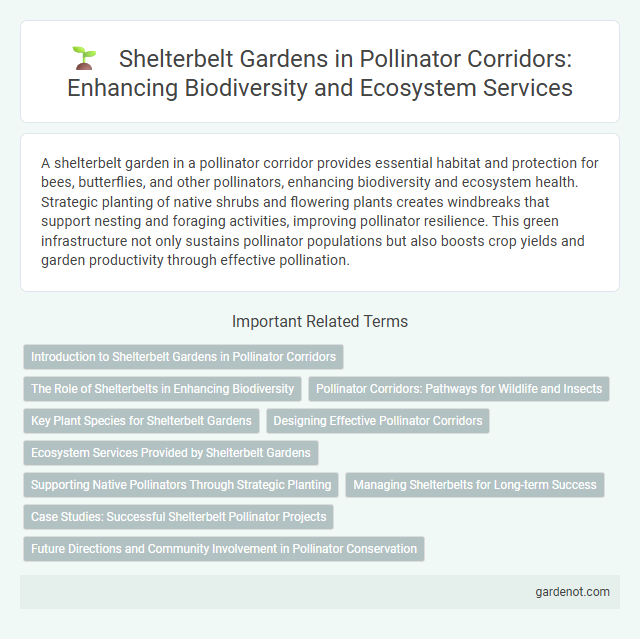A shelterbelt garden in a pollinator corridor provides essential habitat and protection for bees, butterflies, and other pollinators, enhancing biodiversity and ecosystem health. Strategic planting of native shrubs and flowering plants creates windbreaks that support nesting and foraging activities, improving pollinator resilience. This green infrastructure not only sustains pollinator populations but also boosts crop yields and garden productivity through effective pollination.
Introduction to Shelterbelt Gardens in Pollinator Corridors
Shelterbelt gardens serve as crucial protective barriers within pollinator corridors, providing essential habitat and foraging resources for bees, butterflies, and other pollinating insects. These gardens typically consist of rows of trees and shrubs that reduce wind impact, offer shelter, and promote biodiversity in agricultural and urban landscapes. Implementing shelterbelt gardens enhances pollination efficiency by supporting stable pollinator populations and improving ecosystem connectivity.
The Role of Shelterbelts in Enhancing Biodiversity
Shelterbelt gardens serve as critical habitats that support diverse pollinator species by providing shelter, nesting sites, and continuous food sources throughout seasons. These linear plantings reduce wind speed and microclimate extremes, creating favorable conditions for bees, butterflies, and other pollinators to thrive. Integrating native flowering shrubs and trees in shelterbelts boosts pollinator abundance and diversity, directly enhancing local ecosystem resilience and crop pollination services.
Pollinator Corridors: Pathways for Wildlife and Insects
Shelterbelt gardens serve as essential components of pollinator corridors, providing continuous habitat and food sources for wildlife and insects. These linear plantings of native shrubs and flowering species facilitate safe movement and breeding opportunities for pollinators such as bees, butterflies, and hummingbirds. Enhancing biodiversity, shelterbelt gardens combat habitat fragmentation while supporting crucial ecosystem services like pollination and pest control.
Key Plant Species for Shelterbelt Gardens
Key plant species for shelterbelt gardens include native flowering shrubs such as chokecherry (Prunus virginiana), elderberry (Sambucus canadensis), and serviceberry (Amelanchier alnifolia), which provide essential nectar and pollen resources for pollinators. Incorporating deep-rooted trees like cottonwood (Populus deltoides) and silver maple (Acer saccharinum) enhances habitat stability and supports diverse insect communities. Herbaceous perennials such as coneflowers (Echinacea spp.) and goldenrod (Solidago spp.) further enrich shelterbelts by extending bloom periods and attracting a wide range of pollinating insects.
Designing Effective Pollinator Corridors
Shelterbelt gardens play a crucial role in designing effective pollinator corridors by providing diverse, layered vegetation that offers food, shelter, and nesting sites for pollinators such as bees, butterflies, and hummingbirds. Incorporating native flowering plants, shrubs, and trees ensures continuous bloom periods and supports pollinator health and biodiversity. Strategic placement along agricultural edges or urban green spaces enhances connectivity between habitats, facilitating pollinator movement and promoting ecosystem resilience.
Ecosystem Services Provided by Shelterbelt Gardens
Shelterbelt gardens enhance ecosystem services by creating microhabitats that support diverse pollinator populations, promoting biodiversity and improving crop pollination efficiency. These vegetative barriers reduce soil erosion, moderate local climate conditions, and increase water infiltration, contributing to improved soil health and agricultural productivity. The integration of native flowering plants within shelterbelts strengthens food webs, providing critical nectar and pollen resources that sustain pollinator life cycles throughout growing seasons.
Supporting Native Pollinators Through Strategic Planting
Shelterbelt gardens designed with native plants create essential habitats that support native pollinators such as bees, butterflies, and hummingbirds. Strategic planting of diverse, flowering species ensures a continuous source of nectar and pollen, boosting pollinator health and promoting local biodiversity. These gardens serve as critical corridors, linking fragmented ecosystems and facilitating pollinator movement across urban and agricultural landscapes.
Managing Shelterbelts for Long-term Success
Managing shelterbelts for long-term success requires selecting native plant species that provide continuous flowering to support diverse pollinator populations throughout seasons. Regular maintenance, including pruning and pest management, ensures plant health and structural integrity, promoting a resilient habitat corridor. Integrating diverse flowering plants, shrubs, and trees enhances nectar sources, improves biodiversity, and increases pollinator habitat connectivity within shelterbelt gardens.
Case Studies: Successful Shelterbelt Pollinator Projects
Shelterbelt gardens have demonstrated significant success in enhancing pollinator populations by providing continuous habitats and floral resources, as evidenced in case studies from the Midwest United States. These projects show increased diversity and abundance of native bee species, contributing to improved crop pollination and ecosystem resilience. Data from the University of Minnesota highlights a 40% rise in pollinator visits within shelterbelt corridors compared to adjacent monoculture fields.
Future Directions and Community Involvement in Pollinator Conservation
Shelterbelt gardens enhance pollinator corridors by creating diverse habitats that support native bees, butterflies, and other pollinators essential for ecosystem health. Future directions emphasize integrating native plant species and implementing adaptive management practices to increase resilience against climate change. Community involvement through educational workshops and citizen science initiatives fosters stewardship, ensuring long-term conservation success and biodiversity preservation.
Shelterbelt garden Infographic

 gardenot.com
gardenot.com